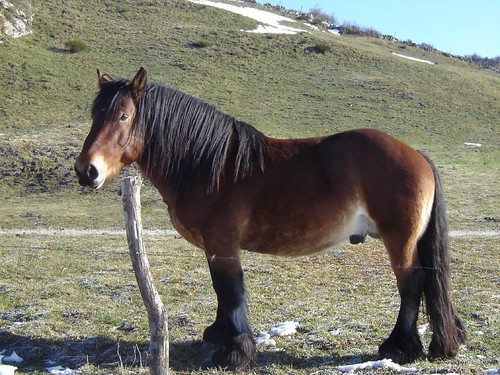The Exmoor skull fits that of living Exmoor so there is no reason to dismiss it as a crossbred or more derived animal. Interestingly, although it has a deep dental on the cheek area to attach large jaw muscles, the more anterior part of the dental is much more massive in the Przewalski skull, probably it its teeth are very deep-ruted. As you see, the eye postorbital area in the Exmoor skull take up a larger proportion of the length than in the Przewalski skull, what means that the snout in the Exmoor is shortened and the eyes are enlarged, a typical domestication effect. That probably also causes the nasal opening to look shorter and the muscle attachment area in the Exmoor's lower jaw to look enlarged relative to the tooth-carrying part of the jaw bone. It also appears to me that the occiput is turned more downwards in the Exmoor, causing the neck vertebrae to be attached more vertically relative to the skull than in the Przewalski. This might be the reason why the Przewalski carries its head less elevated than domestic caballine horses, although I don't regard that necessarily as influenced by domestication.
Having looked at the differences between Exmoor and Przewalski, now let's have a look at the Konik. There is no Konik skull visible on the web, so I laid the Exmoor skull over a Konik from Oostvaardersplassen.
They line up quite well, except that the Konik skull is slightly deeper. That makes the comparison Konik-Przewalski less necessary because the differences will be roughly the same as with the Exmoor.
Now which type of skull did the western subspecies of the wild horse, Equus ferus ferus, the Tarpan if you want, have? The domestication features in the Exmoor and Konik skulls (enlarged eyes, shortened snout) make it unlikely for me that European wild horses had exactly the same skull shape. Historic references of wild horse from the pyrenees, central Europe, eastern Europe and even Russia uniformly describe the heads of wild horses as large, thick and small-eyed. Although that certainly is a useful description for doing a life restoration, it's not precise enough to see if the western wild horse was more like the Prewalski or these two primitive landraces. To get hand of true wild horse skulls from the Holocene of Europe would be needed, but there are no such on the web, at least I didn't find any (if you have, I'd be grateful for a link!), and possibly there are not many confirmed wild horse skulls in the sub-fossil record of Europe because it is hard to distinguish them from domestic horses without genetic testing.
Looking for other primitive caballine landraces that might be interesting for this question, I came up with the Asturcon. Some of these Iberian ponies have a skull basically similar in shape to the Exmoor/Konik, but with smaller eyes and a longer snout, therefore less domestic to my eye (UPDATE: This is in fact a Breton horse, not an Asturcon):
But keep in mind that I'm basing myself here on a very small sample and without having confirmed European wild horse skulls at hand, we can never be sure.




This is excellent.
ReplyDeleteThe last picture is not of a asturcon horse, that
ReplyDeletepicture is confused, and I've seen it before on the
internet. That horse photography is a Spanish-Breton
horse is a heavy horse. The asturcón horse is a small
and lightweight thin-legged horse, usually black, but
also brown asturcones. The horse has not asturcón
long hair on the legs.
This is an asturcon horse. http://www.periodistadigital.com/imagenes/2010/08/30/Foto_1.JPG http://asociacioncaballarlamatina.files.wordpress.com/2010/03/asturcones.jpg
ReplyDeleteOk, thanks for pointing that out! I'll correct that.
DeleteHi! Maybe you have already explained it in another post, but as far as I know there is a European wild horse skull, the skull of the Vedelshave horse, in the Copenhagen Museum. I do not know if you have already analyzed it, but for me it looks closer to the Sorraia horse than to the Konik and Exmoor ponies. I am only analyzing the skulls, which is recorded.
ReplyDeleteSorry. I am the same one who has just written. As I understand Vedelshave horse, it has an antiquity of 10,000 years b.p.
DeleteI think I did analyze and compare the Vedelshave horse skull with those of Sorraias in a 2015 post or so, and indeed they line up quite well, but that is not exclusive to the Sorraia. I am actually currently working on a reconstruction sculpture of the Vedelshave skeleton, I plan to give it a black dun colouration.
Delete